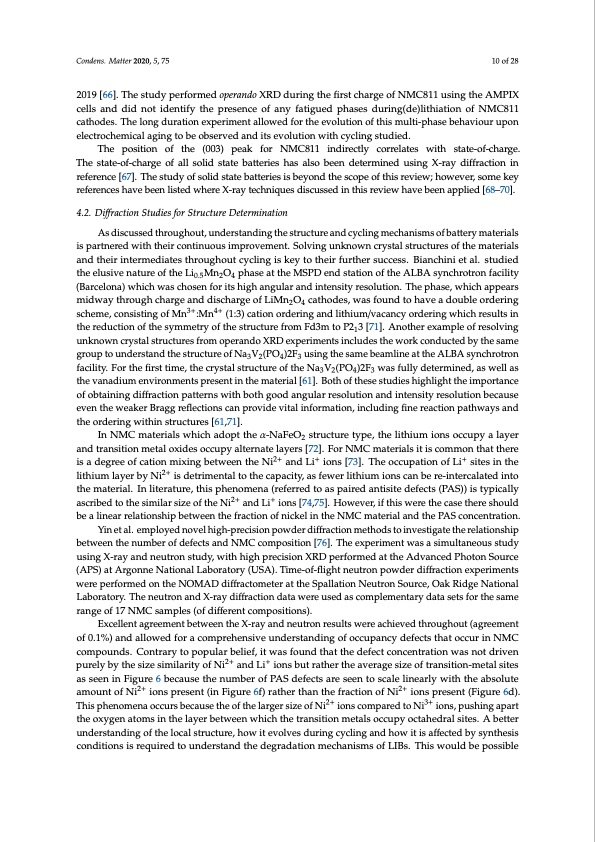
PDF Publication Title:
Text from PDF Page: 010
Condens. Matter 2020, 5, 75 10 of 28 2019 [66]. The study performed operando XRD during the first charge of NMC811 using the AMPIX cells and did not identify the presence of any fatigued phases during(de)lithiation of NMC811 cathodes. The long duration experiment allowed for the evolution of this multi-phase behaviour upon electrochemical aging to be observed and its evolution with cycling studied. The position of the (003) peak for NMC811 indirectly correlates with state-of-charge. The state-of-charge of all solid state batteries has also been determined using X-ray diffraction in reference [67]. The study of solid state batteries is beyond the scope of this review; however, some key references have been listed where X-ray techniques discussed in this review have been applied [68–70]. 4.2. Diffraction Studies for Structure Determination As discussed throughout, understanding the structure and cycling mechanisms of battery materials is partnered with their continuous improvement. Solving unknown crystal structures of the materials and their intermediates throughout cycling is key to their further success. Bianchini et al. studied the elusive nature of the Li0.5Mn2O4 phase at the MSPD end station of the ALBA synchrotron facility (Barcelona) which was chosen for its high angular and intensity resolution. The phase, which appears midway through charge and discharge of LiMn2O4 cathodes, was found to have a double ordering scheme, consisting of Mn3+:Mn4+ (1:3) cation ordering and lithium/vacancy ordering which results in the reduction of the symmetry of the structure from Fd3m to P213 [71]. Another example of resolving unknown crystal structures from operando XRD experiments includes the work conducted by the same group to understand the structure of Na3V2(PO4)2F3 using the same beamline at the ALBA synchrotron facility. For the first time, the crystal structure of the Na3V2(PO4)2F3 was fully determined, as well as the vanadium environments present in the material [61]. Both of these studies highlight the importance of obtaining diffraction patterns with both good angular resolution and intensity resolution because even the weaker Bragg reflections can provide vital information, including fine reaction pathways and the ordering within structures [61,71]. In NMC materials which adopt the α-NaFeO2 structure type, the lithium ions occupy a layer and transition metal oxides occupy alternate layers [72]. For NMC materials it is common that there is a degree of cation mixing between the Ni2+ and Li+ ions [73]. The occupation of Li+ sites in the lithium layer by Ni2+ is detrimental to the capacity, as fewer lithium ions can be re-intercalated into the material. In literature, this phenomena (referred to as paired antisite defects (PAS)) is typically ascribed to the similar size of the Ni2+ and Li+ ions [74,75]. However, if this were the case there should be a linear relationship between the fraction of nickel in the NMC material and the PAS concentration. Yin et al. employed novel high-precision powder diffraction methods to investigate the relationship between the number of defects and NMC composition [76]. The experiment was a simultaneous study using X-ray and neutron study, with high precision XRD performed at the Advanced Photon Source (APS) at Argonne National Laboratory (USA). Time-of-flight neutron powder diffraction experiments were performed on the NOMAD diffractometer at the Spallation Neutron Source, Oak Ridge National Laboratory. The neutron and X-ray diffraction data were used as complementary data sets for the same range of 17 NMC samples (of different compositions). Excellent agreement between the X-ray and neutron results were achieved throughout (agreement of 0.1%) and allowed for a comprehensive understanding of occupancy defects that occur in NMC compounds. Contrary to popular belief, it was found that the defect concentration was not driven purely by the size similarity of Ni2+ and Li+ ions but rather the average size of transition-metal sites as seen in Figure 6 because the number of PAS defects are seen to scale linearly with the absolute amount of Ni2+ ions present (in Figure 6f) rather than the fraction of Ni2+ ions present (Figure 6d). This phenomena occurs because the of the larger size of Ni2+ ions compared to Ni3+ ions, pushing apart the oxygen atoms in the layer between which the transition metals occupy octahedral sites. A better understanding of the local structure, how it evolves during cycling and how it is affected by synthesis conditions is required to understand the degradation mechanisms of LIBs. This would be possiblePDF Image | Synchrotron-Based X-ray Diffraction for Lithium-Ion Batteries

PDF Search Title:
Synchrotron-Based X-ray Diffraction for Lithium-Ion BatteriesOriginal File Name Searched:
condensedmatter-05-00075.pdfDIY PDF Search: Google It | Yahoo | Bing
Sulfur Deposition on Carbon Nanofibers using Supercritical CO2 Sulfur Deposition on Carbon Nanofibers using Supercritical CO2. Gamma sulfur also known as mother of pearl sulfur and nacreous sulfur... More Info
CO2 Organic Rankine Cycle Experimenter Platform The supercritical CO2 phase change system is both a heat pump and organic rankine cycle which can be used for those purposes and as a supercritical extractor for advanced subcritical and supercritical extraction technology. Uses include producing nanoparticles, precious metal CO2 extraction, lithium battery recycling, and other applications... More Info
| CONTACT TEL: 608-238-6001 Email: greg@infinityturbine.com | RSS | AMP |